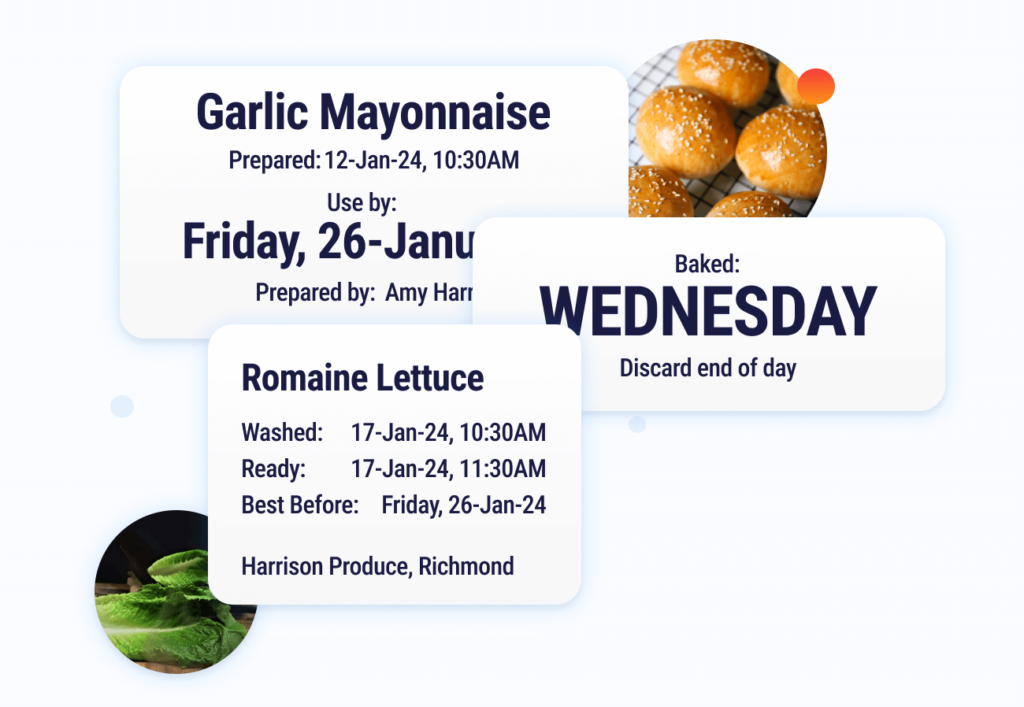Shelf-life tracking and labeling with restaurant management software
Still using masking tape and hand-written labels in the kitchen? There’s a better way! Let’s take a look at how automated shelf life tracking and labeling software – complemented by tools like inventory checklists – can help enhance your hospitality venue’s food safety and compliance. Because you want to create the right kind of unforgettable experience for diners!

Understanding shelf-life tracking
Using masking tape and a sharpie is fine, but how do you track things like use by dates and ingredients lists? That’s a lot of information to remember… Forgetting could be costly.
Recording and reviewing the shelf-life of your ingredients is crucial to ensure you:
- Meet customer expectations for delicious and safe meals.
- Prevent foodborne illnesses and safeguard the health of diners.
- Protect your venue’s image and avoid negative reviews.
- Adhere to strict standards and regulations for legal operation.
- Optimize resource usage, minimize wastage, and streamline kitchen operations.
We get it, it can be difficult to maintain freshness and food safety standards in a busy environment. This is precisely why implementing tools like an inventory checklist can be a game-changer.
Using an automated inventory checklist
An inventory checklist can act as the custodian of your kitchen’s freshness. It involves using a list to check and note down the amount, quality, and expiration dates of every ingredient in your kitchen. Your chefs can easily identify expired items, thanks to the expiration date or colored day dot, and keep the venue’s inventory neat and well-organized.
Without a reliable checklist, mistakes are bound to happen. We recommend you keep your checklist updated regularly to show the current status of items. Then, ensure your staff knows the checklist well to minimize mistakes.
Labeling best practices
Does your staff have neat handwriting? Labels need to be easily read in a busy and hot environment. They should also be standardized i.e., follow a template. This template should include crucial details like:
- Expiry dates
- Colored day dot
- Preparation dates
- Allergen information.
When your chefs can clearly read and understand a food label, they can make quick and precise decisions about which ingredients to use. This thwarts potential health risks associated with misidentification and helps streamline kitchen processes. Ultimately, this contributes to a safer environment for patrons.
Having food labels with an agreed-upon template is essential. But this is just one way labeling can enhance food safety; others include:
- Avoid overlapping your labels with other labels or packaging.
- Remove and replace labels that have become illegible or damaged.
- Train kitchen staff on the importance of accurate labeling.
- Ensure all labeling practices are compliant to align with health department requirements.
Labeling with masking tape and a permanent marker is the traditional method, but there’s a better way. Automate with easy-to-use restaurant management software!
Utilizing restaurant management software
Consider a scenario in a high-traffic restaurant where multiple chefs are simultaneously working on various dishes. During peak times, there’s a heightened risk of confusion if the ingredients have inconsistent labeling. Something may make sense to one chef and be puzzling to the other. Perhaps English isn’t someone’s first language and the hand-written label looks like a doctor has written it. This is where mistakes are made.
Restaurant management software can easily handle product names and expiration dates from any device. You can tailor it to suit your specific product and ingredient requirements, and get reminders of when a use by date is approaching.
Lastly and simply, it prints your labels for you. No more handwriting issues.
You can also learn more about restaurant automation system in our in-depth guide
Implementation and integration
Now comes the fun part: incorporating these practices into your venue. To make this work in a busy kitchen, it needs to be put into action smoothly. Make shelf-life tracking and food labeling a natural part of the daily kitchen routine.
Before the venue opens for the day, ensure your kitchen staff review the ingredients on hand. Here they can:
- Identify what can be used and what needs to be thrown out.
- Determine what will need to be ordered from suppliers.
Another benefit of shelf-life tracking is the data you acquire. Suppose you consistently have to throw out produce and are uncertain why. This can help identify issues like over-ordering, unpopular ingredients, or even faulty refrigeration.
When it comes to labeling, adding newer processes, like printing, is much easier than you think. For example, a process you could incorporate is this:
- When ingredients arrive, ensure they’re checked for freshness and labeled with the printed label.
- Then, store them in an appropriate setting with the label displayed clearly.
- At the beginning of every shift, the labels are checked, and a decision can be made on the suitability of the ingredients. You’ll also have a handy failsafe reminder set up on your digital platform.
Empowers chefs to make quick decisions, ensuring expired items are avoided and the kitchen stays in full swing.
Benefits and impact
As ingredients are tracked for freshness and labeled precisely, the impact can be immediate. Avoiding expired items creates an environment where chefs confidently create dishes with the best-quality ingredients. It goes beyond this, of course. Other benefits include:
- Boosted efficiency: Streamline kitchen operations, making it easier for staff to locate ingredients and reducing the risk of errors.
- Waste reduction: Accurate tracking and labeling minimize food waste by ensuring the timely use of ingredients before expiration.
- Quality assurance: Precise labeling guarantees your chefs work with fresh ingredients, maintaining the quality and taste of dishes.
- Positive customer experiences: Patrons enjoy dishes made with care and attention to freshness and safety.
Uphold freshness and safety with Operandio
Operandio’s smart food labeling system is automating processes and revolutionizing how kitchens handle shelf-life tracking and food safety compliance:
- Automated accuracy: Operandio’s system automates labeling, ensuring 100% accuracy and food safety compliance.
- Effortless management: Create and manage label templates easily across all locations with Operandio’s user-friendly cloud-based platform.
- Instant updates: Update date codes, product names, and settings instantly from any device, ensuring uniformity and compliance.
- Quick label printing: Operandio speeds up label printing, allowing staff to focus on customer service instead of manual tasks.
- Easy integration: No learning curve – Operandio’s turnkey solution is ready to use, simplifying food preparation with just a touch.
Join other businesses worldwide using Operandio to manage their day-to-day operations and book your demo today.


